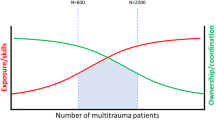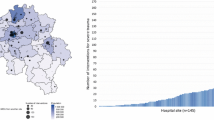Abstract
The quality of trauma care for severely injured patients in Germany varies widely. This is due to regional geographical differences as well as variations of in-hospital treatment concepts for trauma care. Improving trauma care quality in our country is possible by standardizing structural and personal resources within trauma care levels. Better care for the severely injured thus also requires the establishment of a (nationwide) local trauma network. Within the ‘Recommendations for Structure and Organization of Institutions Involved in Trauma Care’ of the German Society of Trauma Surgery the concepts for regional trauma networks including recommendations for structural and personal conditions and organizational planning for hospitals taking part in the care of severely injured patients in Germany are described.
The common goal is, in contrast to current tendencies in the German medical system, to define the demands in resources and organization in all institutions, also the smaller institutions separate from level 1 trauma centres, thus guaranteeing equally high treatment quality in every part of the country. The presented article details the steps that are to be undertaken to establish a functioning, efficient trauma network.
Zusammenfassung
Die Qualität der Polytraumaversorgung in Deutschland ist – bedingt durch geographische Unterschiede zwischen den Bundesländern und durch die Abweichung der Behandlungskonzepte in einzelnen Krankenhäusern sehr inhomogen. Um eine weitere Verbesserung der Polytraumaversorgung in Deutschland zu gewährleisten erscheint es sinnvoll, strukturelle und personelle Voraussetzungen in der Versorgung schwerverletzter Patienten in den jeweiligen Versorgungsstufen weitestgehend zu standardisieren und die Kliniken in lokalen Traumanetzwerken zusammenzufassen.
Die Voraussetzungen für regionale Traumanetzwerke sowie für die strukturelle, personelle Ausstattung und Organisation der zukünftig mit der Schwerverletztenversorgung betrauten Kliniken wurden in dem Weißbuch ,Schwerverletztenversorgung – Empfehlungen zur Struktur und Organisation von Einrichtungen zur Behandlung von Schwerverletzten in der Bundesrepublik‘ zusammengefasst.
Das gemeinsame Ziel ist es, entgegen der derzeitigen Entwicklung im deutschen Gesundheitssystem eindeutige Anforderungen an Struktur, Organisation und Ausstattung für eine kompetente und nachhaltige Schwerverletz tenversorgung auch außerhalb von Ballungszentren festzulegen, um damit eine einheitlich hohe Versorgungsqualität zu gewährleisten.
Die einzelnen Schritte zur Umsetzung eines Netzwerks werden im Rahmen dieses Artikels aufgezeigt.
Similar content being viewed by others
Literatur
Biewener A, Aschenbrenner U, Rammelt S, Grass R, Zwipp H (2004) Impact of helicopter transport and hospital level on mortality of polytrauma patients. J Trauma 56:94–98
Cales RH, Ehrlich F, Sacra J, Cross R Jr, Ervin ME (1987) Trauma care system guidelines: improving quality through the systems approach. Ann Emerg Med 16:464
Champion HR, Sacco WJ, Copes WS (1992) Improvement in outcome from trauma center care. Arch Surg 127:333–338
Cooper A, Hannan EL, Bessey PQ, Farrell LS, Cayten CG, Mottley L (2000) An examination of the volume- mortality relationship for New York State trauma centers. J Trauma 48:16–24
Haas NP, von Fournier C, Tempka A, Sudkamp NP (1997) Traumazentrum 2000. Wie viele und welche Traumazentren braucht Europa um das Jahr 2000. Unfallchirurg 100:852–858
Hulka F, Mullins RJ, Mann NC, Hedges JR, Rowland D, Worrall WH, Sandoval RD, Zechnich A, Trunkey DD (1997) Influence of a statewide trauma system on pediatric hospitalization and outcome. J Trauma 2:514–519
Kane G, Wheeler NC, Cook S, Englehardt R, Pavey B, Green K, Clark ON, Cassou J (1992) Impact of the Los Angeles County Trauma System on the survival of seriously injured patients. J Trauma 2:576–583
Kühne CA, Ruchholtz S, Buschmann C, Sturm J, Lackner CK, Wentzensen A, Bouillon B, Waydhas C, Weber C, Initiative Traumanetzwerk DGU (2006) Polytraumaversorgung in Deutschland – eine Standortbestimmung. Unfallchirurg 109:357–366
Liener UC, Rapp U, Lampl L, Helm M, Richter G, Gaus M, Wildner M, Kinzl L, Gebhard F (2004) Inzidenz schwerer Verletzungen – Ergebnisse einer populationsbezogenen Untersuchung. Unfallchirurg 107:483–490
Mullins RJ, Mann NC (1999) Population- based research assessing the effectiveness of trauma systems. J Trauma 47:59–66
Norwood S, Myers MB (1994) Outcomes following injury in a predominantly rural-population-based trauma center. Arch Surg 29:800–805
Ruchholtz S, AG Polytrauma (2000) Das Traumaregister der Deutschen Gesellschaft für Unfallchirurgie als Grundlage des interklinischen Qualitätsmanagements in der Schwerverletztenversorgung. Unfallchirurg 103:30–37
Ruchholtz S, Waydhas C, Lewan U et al (2002) A multidisciplinary quality management system for the early treatment of severely injured patients: implementation and results in two trauma centers. Intensive Care Med 28:1395–1404
Rutledge R, Fakhry SM, Meyer A, Sheldon GF, Baker CC (1993) An analysis of the association of trauma centers with per capita hospitalizations and death rates from injury. Ann Surg 18:512–521
Shackford SR, Hollingworth-Fridlund P, Cooper GF, Eastman AB (1986) The effect of regionalization upon the quality of trauma care as assessed by concurrent audit before and after institution of a trauma system: a preliminary report. J Trauma 26:812–820
Shackford SR, Hollingsworth-Fridlund P, McArdle M, Eastman AB (1987) Assuring quality in a trauma system – the Medical Audit Committee: composition, cost, and results. J Trauma 27:866–875
Shackford SR, Mackersie RC, Hoyt DB, Baxt WG, Eastman AB, Hammill FN, Knotts FB, Virgilio RW (1987) Impact of a trauma system on outcome of severely injured patients. Arch Surg 122:523–527
Statistisches Bundesamt (2004) Internet: http://www.destatis.de/
Sturm JA, Lackner CK, Bouillon B, Seekamp A, Mutschler WE (2002) Advanced Trauma Life Support (ATLS). Unfallchirurg 105:1027–1032
Tepas JJ 3rd, Patel JC, DiScala C, Wears RL, Veldenz HC (1998) Relationship of trauma patient volume to outcome experience: can a relationship be defined? J Trauma 44:827–831
Wissenschaftlicher Arbeitskreis Neuroanästhesie der Deutschen Gesellschaft für Anästhesiologie und Intensivmedizin, Arbeitsgemeinschaft Intensivmedizin und Neurotraumatologie der Deutschen Gesellschaft für Neurochirurgie, Sektion Rettungswesen und Katastrophenmedizin der Deutschen Interdisziplinären Vereinigung für Intensiv- und Notfallmedizin. Empfehlungen zur Erstversorgung des Patienten mit Schädel-Hirn-Trauma bei Mehrfachverletzung. In: Opderbecke HW, Weißbauer W (Hrsg) 2000
Zulick LC, Dietz PA, Brooks K (1991) Trauma experience of a rural hospital. Arch Surg 26:14
Author information
Authors and Affiliations
Consortia
Corresponding author
Additional information
Serie: Die Intensivtherapie bei Traumen und Polytraumen Herausgegeben von I. Marzi (Frankfurt/Main)
Mitglieder der Initiative TraumanetzwerkD: Priv.-Doz. Dr. H. J. Bail (Berlin), Priv.-Doz. Dr. A. Beck (Ulm), Prof. Dr. B. Bouillon (Köln), Dr. S. Hentsch (Koblenz), Dr. C.A. Kühne (Essen), Prof. Dr. C. Lackner (München), Prof. Dr. U. Obertacke (Mannheim), Prof. Dr. S. Ruchholtz (Essen), Prof. Dr. A. Seekamp (Kiel), Prof. Dr. J. Sturm (Detmold), Prof. Dr. C. Waydhas (Essen), Prof. Dr. A. Wentzensen (Ludwigshafen)
Rights and permissions
About this article
Cite this article
Ruchholtz, S., Kühne, C.A., Sturm, J. et al. Die Umsetzung des Traumanetzwerks. Intensivmed 44, 142–148 (2007). https://doi.org/10.1007/s00390-007-0788-4
Received:
Accepted:
Issue Date:
DOI: https://doi.org/10.1007/s00390-007-0788-4




